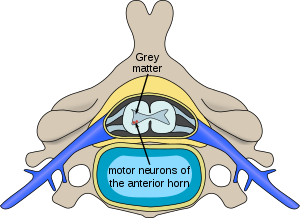Werdnig–Hoffmann disease
| Spinal muscular atrophy | |
|---|---|
| Synonyms | Autosomal recessive proximal spinal muscular atrophy, 5q spinal muscular atrophy |
 |
|
| Location of neurons affected by spinal muscular atrophy in the spinal cord | |
| Specialty | Medical genetics |
| Classification |
· ·
|
|---|---|
| External resources |
Spinal muscular atrophy (SMA) in order to distinguish it from other conditions with similar names, is a rare neuromuscular disorder characterised by loss of motor neurons and progressive muscle wasting, often leading to early death.
The disorder is caused by a genetic defect in the SMN1 gene, which encodes SMN, a protein widely expressed in all eukaryotic (ex: human) cells and necessary for survival of motor neurons. Lower levels of the protein results in loss of function of neuronal cells in the anterior horn of the spinal cord and subsequent system-wide atrophy of skeletal muscles.
Spinal muscular atrophy manifests in various degrees of severity, which all have in common progressive muscle wasting and mobility impairment. Proximal muscles, arm and leg muscles that are closer to the torso and respiratory muscles are affected first. Other body systems may be affected as well, particularly in early-onset forms of the disorder. SMA is the most common genetic cause of infant death.
Spinal muscular atrophy is an inherited disorder and is passed on in an autosomal recessive manner (see video explaniation of autosomal recessive inheritance). In December 2016, nusinersen became the first approved drug to treat SMA while several other compounds remain in clinical trials.
SMA manifests over a wide range of severity, affecting infants through adults. The disease spectrum is variously divided into 3–5 types, in accordance either with the age of onset of symptoms or with the highest attained milestone of motor development.
...
Wikipedia
